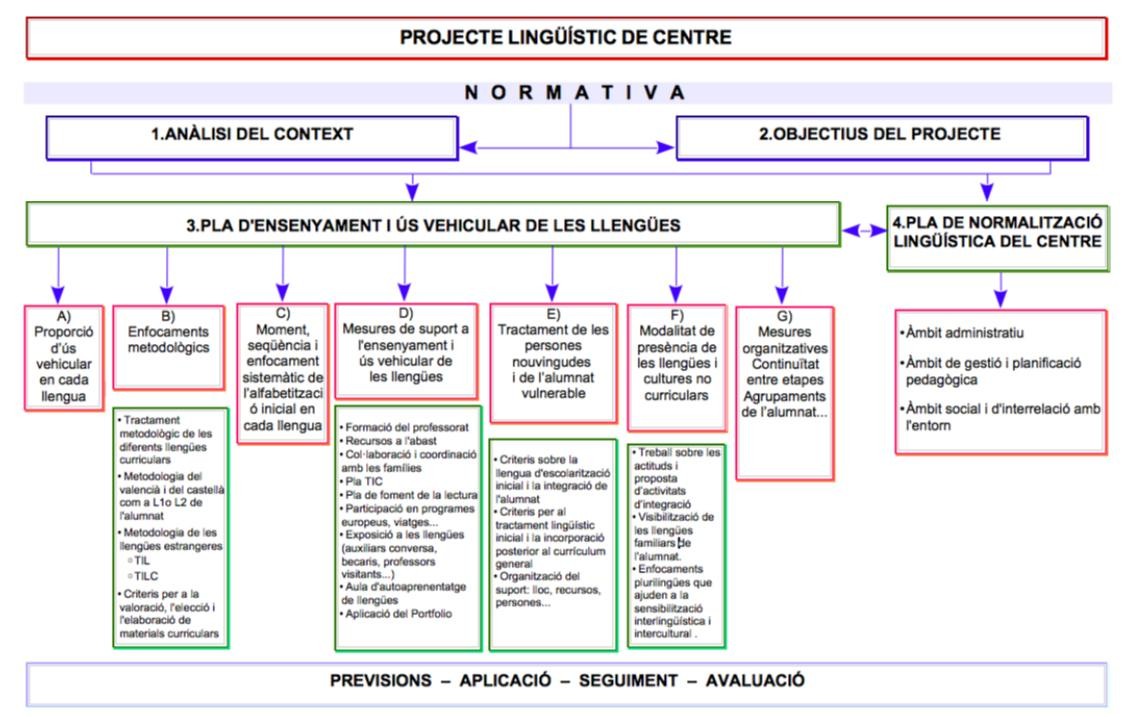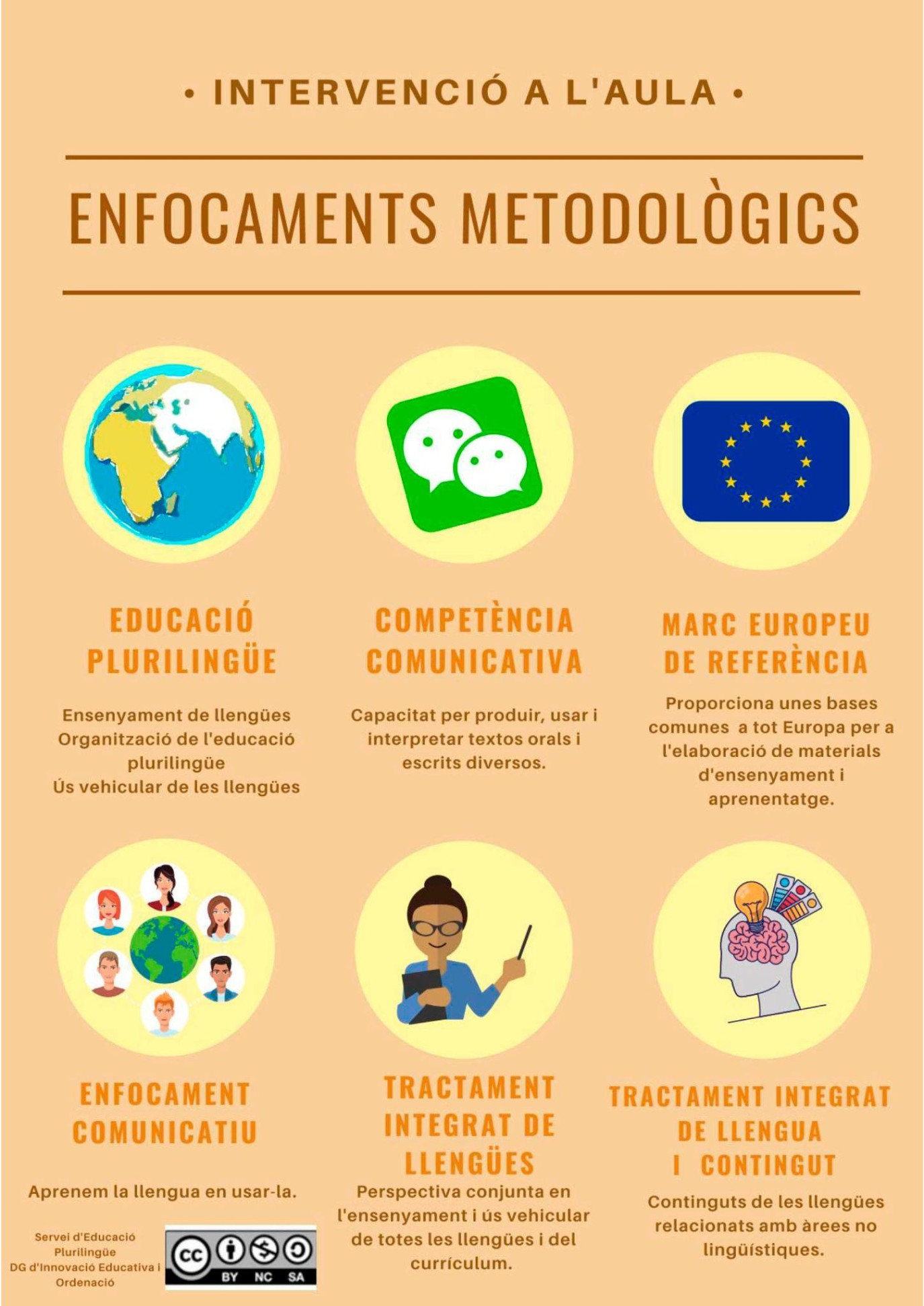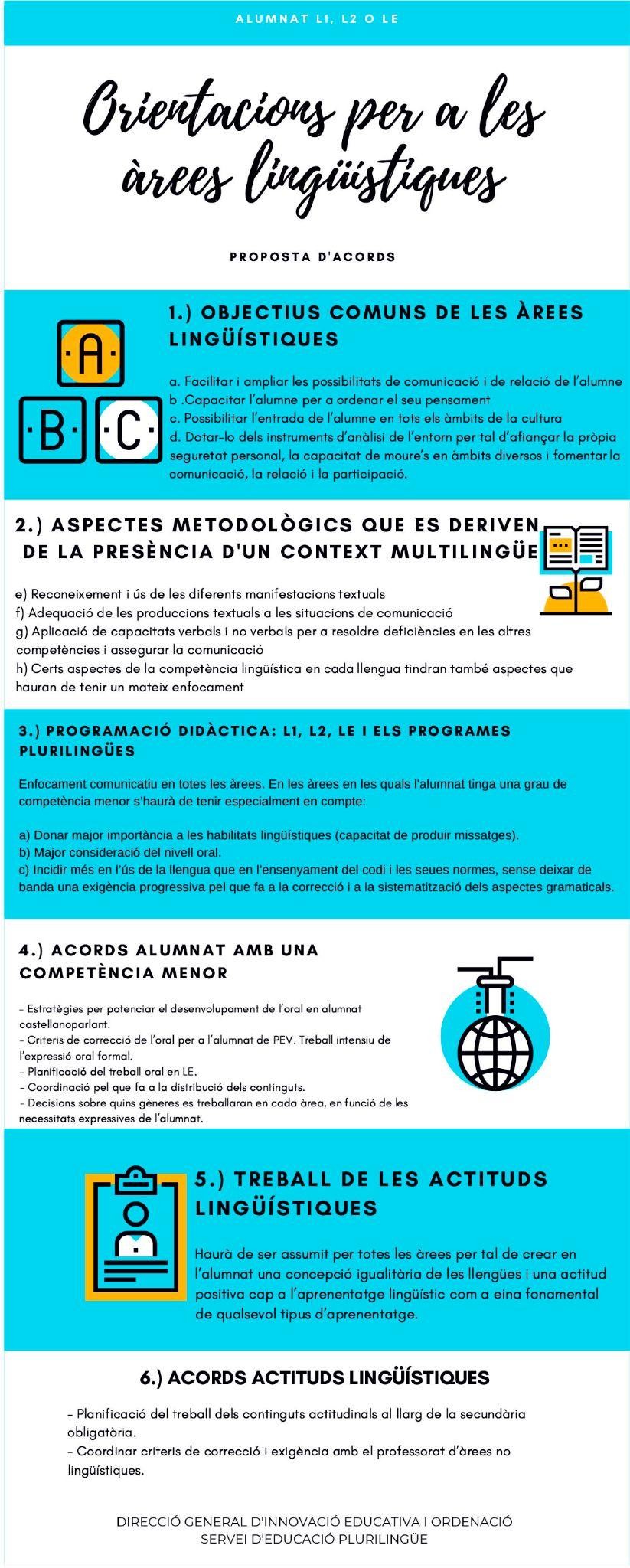The transversality of minority languages in planning and in the classroom
“The central role of verbal language in schooling, the linguistic diversity of schoolchildren and the curricular prescriptions that demand the teaching of two or three languages require language teaching planning that is the responsibility of all teachers and not only of those teaching” (Guasch, 2011)
6.1. THE TRANSVERSALITY OF MINORITIZED LANGUAGES IN CLASSROOM MANAGEMENT AND PREPARATION.
“Science teachers should write poetry and language teachers should study science” (Lemke, Jay L.)
Coordinating the language learning that takes place in all the curricular areas signifies the need to connect the different languages taught in the centers through all the teaching and learning activities. Also with respect to the didactic proposals focused on the linguistic aspects of the other curricular areas, based on the fact that formal teaching-learning is based on the comprehensive manipulation of oral and written texts.
The Linguistic Plan of the Center (PLC)
Planning for the teaching and treatment of languages in schools, in some educational administrations of the Spanish State, must be formalized in a document: the Linguistic Plan of the Center (PLC), which describes the schools’ sociolinguistic reality, the detection of the student’s problems and difficulties for the linguistic education, and proposals made to overcome these difficulties (Ferrer, 1997; Guasch, 2007, 2011a; Ruiz Bikandi, 1997). In order to avoid student segregation, the PLC must equally distribute curricular time in each of the vehicular languages to all students in the course.
The PLC, as part of the Educational Plan of the Center (PEC), is the organized collection of agreements that the educational community elaborates on the educational proposals for the teaching and learning of languages and communication. It is a tool for the consistent and effective development of the center’s educational activities. The information and instructions for the preparation of this tool, as a pedagogical tool, must be flexible and adaptable to all environments. It is advisable to avoid the complexity of the more formal and legal aspects that may constrain the project into a simple administrative document, without any function in terms of the center’s educational activity. It is therefore necessary to insist that the Administration facilitate and accelerate the preparation of the document that specifies the PLC, thus impacting the agreements for the centers daily educational management. The PLC must strive to guarantee the right of all children living in Catalonia to be able to use Catalan and Spanish for multiple purposes, orally and written, with the use of the different means of communication with the languages used (especially audiovisual). It must also provide clues to help develop a multilingual competence that allows for effective use for a spectrum of text and from different linguistic and cultural origins. To achieve this, the PLC will have to consider different areas: the social environment of the school, the center as a communicative space and the specific classes.
Extracted from Consell assessor de la llengua a l’escola: Conclusions. Department of Education and Universities. Government of Catalonia.
PLC diagram:
Table 1: Structure of the Linguistic Plan of the Center (Source: Ministry of Education, Culture and Sport of the Generalitat Valenciana, 2018)
The Language Plan that each center must develop includes, within the various organizational sections, a specific section on methodological approaches in the treatment of the different curricular languages, both considered as vehicular or as second languages. The Guide for the elaboration of the Linguistic Plan of the Center (Secondary education, Baccalaureate, Professional Training and Adult Education) of the Plurilingual Education Advisory Board for Educational Innovation and Organization demonstrates a series of actions or methodological actions that educational centers must assess. In the Methodological Approaches of the Linguistic Plan of the Center (PLC), each action is developed with specific proposals.
The communicative approach is the indispensable aspect that must be present in all proposals for the selection of materials in the language areas. Several authors define what a communicative approach signifies:
“Speech acts are performed within linguistic activities, but these activities are part of a wider social context, which is the only one capable of giving them complete meaning. We talk about tasks in the sense that they are actions carried out by one or more people who strategically use their own specific skills in order to achieve a certain result. The action-based approach, therefore, also takes into account cognitive, emotional and voluntary resources, and the full range of specific capacities that individuals apply as social agents.” (MECR, 2003, 27).
“Communicative activities must allow students to develop strategies and skills to communicate their message effectively, although grammatical accuracy is often sacrificed in favor of communicative effectiveness.” (Littlewood 1998).
It is necessary to distinguish between two types of competences, which are interrelated:
• Global skills: they are necessary to carry out actions of all kinds, including language activities.
• Communicative language skills: they enable the use of specific linguistic means. They are activated by carrying out various linguistic activities, which include reception, production, interaction or mediation.
When distributing the curricular contents, it is necessary to first identify which contents are shared by the different language subjects by level and which they can collaborate on. To do this, we must start from the Bridge Document (see bibliography) for each subject, which contains the contents, evaluation criteria, success indicators, stage objectives and skills of each course.
Table 2: Intervention in the classroom. Excerpt from the Guide for the preparation of the Linguistic Plan of the Center.
Multilingual Education Service.
It is therefore evident that it is necessary to reach a methodological agreement following the Content and Language Integrated Learning (CLIL), which involves working with languages collaboratoriatively, and not as separate entities. Language skills are developed through tasks with an explicit communicative purpose. Additionally, this ensures the largest possible variety of genres, which guarantees the study of various pragmatic-linguistic aspects. Once it has been agreed how the contents of the three language areas will be distributed, the second foreign language can be added. Dual programming implies that some common content is taught in two or more areas and others are distributed separately in a balanced manner.
Table 3: Guidelines for language areas: Working with the L1, L2, L3 in multilingual contexts. Multilingual Education Service.
Other recommended actions for the PLC:
-
Coordinate with language departments to decide which linguistic and communicative content is included as part of the assessment of the subject, area or non-linguistic module.
-
Coordinate correction criteria and linguistic requirements with the teaching staff of non-linguistic subjects.
-
Plan the organization of the center in order to facilitate work by area, shared teaching, flexible groupings, etc. that make the CLIL effective.
-
Organize the content and curricular skills in interdisciplinary projects that make effective the communicative approach to languages and that encourage the inclusion of students.
More information in Methodological approaches: Linguistic Plan of the Center (PLC). SUPPORT MATERIAL FOR THE GUIDE FOR THE PREPARATION OF THE LINGUISTIC PLAN OF THE CENTER (SECONDARY, BACCALAUREATE, PROFESSIONAL TRAINING AND ADULT EDUCATION). General Directorate of Educational Innovation and Multilingual Education Service Organization. Ministry of Education, Culture and Sport. Valencian government.
“El rol central del llenguatge verbal en l’escolarització, la diversitat lingüística dels escolars i les prescripcions curriculars que demanden l’ensenyament de dues o tres llengües requereixen una planificació de l’ensenyament de les llengües que incumbeix tot el professorat i no únicament el de llengües” (Guasch, 2011)
6.1. LA TRANSVERSALITAT DE LES LLENGÜES MINORITZADES EN LA PLANIFICACIÓ I L’AULA
“El professorat de ciència ha de fer poesia i el de llengua llegir ciència” (Lemke, Jay L.)
Coordinar els aprenentatges lingüístics que es produeixen en totes les àrees curriculars suposa la necessitat de posar en contacte totes les activitats d’ensenyament aprenentatge de les diferents llengües que s’ensenyen als centres. També respecte a les propostes didàctiques centrades en els aspectes lingüístics de la resta d’àrees curriculars, tot partint del fet que l’ensenyament-aprenentatge formal es basa en la manipulació comprensiva de textos orals i escrits.
El Projecte Lingüístic de Centre
La planificació sobre l’ensenyament i el tractament de les llengües als centres escolars, en algunes administracions educatives de l’Estat espanyol, s’ha de formalitzar en un document: el Projecte Lingüístic de Centre (PLC), en què es descriu la realitat sociolingüística dels centres, es detecten els problemes i les dificultats per a l’educació lingüística dels estudiants i es fan propostes per a la seua superació (Ferrer, 1997; Guasch, 2007, 2011a; Ruiz Bikandi, 1997). Amb l’objectiu d’evitar la segregació de l’alumnat, el PLC ha d’aplicar la mateixa distribució del temps curricular en cadascuna de les llengües vehiculars a tot l’alumnat del mateix curs.
El PLC, com a part del projecte educatiu de centre (PEC), és el recull organitzat dels acords que sobre les propostes educatives per a l’ensenyament i l’aprenentatge de les llengües i la comunicació va elaborant la comunitat educativa. És un instrument per al desenvolupament coherent i eficaç de les activitats educatives del centre. Les informacions i instruccions per a l’elaboració d’aquest instrument, com a eina pedagògica, han de ser flexibles i adaptables a tots els entorns. Convé evitar que la complexitat dels aspectes més formals i legals acabin essent una cotilla que converteixi el projecte en un simple document administratiu, sense cap funció quant a l’activitat educativa del centre. Caldrà, per tant, insistir perquè l’Administració faciliti i agiliti l’elaboració del document que concreti el PLC a fi que acabi incidint en els acords de la gestió educativa diària dels centres. El PLC ha de tenir la funció de garantir el dret de tots els infants que viuen a Catalunya de poder fer servir el català i el castellà per a finalitats múltiples, de manera oral i escrita, amb l’ús dels diferents mitjans de comunicació amb els llenguatges que vehiculen (especialment l’audiovisual). També ha de donar pistes per ajudar en el desenvolupament d’una competència plurilingüe que permeti fer servir textos de tota mena i de diferent procedència lingüística i cultural de manera eficaç. Per aconseguir-ho, el PLC haurà de considerar diferents àmbits: l’entorn social de l’escola, el centre com a espai comunicatiu i les classes concretes.
Extret de Consell assessor de la llengua a l’escola: Conclusions. Departament d’Educació i Universitats. Generalitat de Catalunya.
Esquema del PLC:
Quadre 1: Estructura del Projecte Lingüístic de Centre. (Font: Conselleria d’Educació, Cultura i Esport de la Generalitat Valenciana, 2018)
En el Projecte lingüístic que cada centre ha de desenvolupar s’inclouen, dins dels diversos apartats organitzatius, un apartat específic sobre enfocaments metodològics en el tractament de les diferents llengües curriculars, tant contemplades com a vehiculars o com a llengües d’àrea. La Guia per a l’elaboració del Projecte lingüístic de centre (centres d’ESO, Batxillerat, FP i FPA) de l’Assessoria d’Educació Plurilingüe-DG d’Innovació Educativa i Ordenació mostra una sèrie d’accions o actuacions metodològiques que els centres educatius han de valorar i fer seues de manera progressiva. En els Enfocaments metodològics projecte Lingüístic de Centre (PLC) es desenvolupa cada acció amb propostes concretes.
L’enfocament comunicatiu és l’aspecte irrenunciable que ha d’estar present en totes les propostes de selecció de materials de les àrees lingüístiques. Diversos autors han definit què s’entén per enfocament comunicatiu:
“Els actes de parla es realitzen dins de les activitats lingüístiques, però aquestes activitats formen part d’un context social més ampli, que és l’únic capaç de donar-los una significació completa. Parlem de tasques en el sentit que es tracta d’accions realitzades per una o més persones que utilitzen estratègicament les seues pròpies competències específiques per tal d’aconseguir un resultat determinat. L’enfocament basat en l’acció, per tant, també té en compte els recursos cognitius, emocionals i volitius, i tot el ventall complet de capacitats específiques que els individus apliquen com a agents socials.” (MECR, 2003, 27).
«Les activitats comunicatives han de permetre a l’alumnat desenvolupar estratègies i habilitats per comunicar el seu missatge de manera eficaç encara que sovint la precisió gramatical es veu sacrificada a favor de l’eficàcia comunicativa.» (Littlewood 1998).
Cal distingir entre dos tipus de competències, interrelacionades:
• Les competències globals: són les necessàries per dur a terme accions de tota mena, incloent-hi les activitats de llengua.
• Les competències lingüístiques comunicatives: són les que capaciten per actuar utilitzant específicament mitjans lingüístics. S’activen amb la realització de diverses activitats lingüístiques, que comprenen la recepció, la producció, la interacció o la mediació.
A l’hora de fer la distribució dels continguts curriculars, cal identificar en un primer moment quins continguts comparteixen les diferents assignatures lingüístiques per nivells i en quins poden col·laborar. Per a fer això, hem de partir del Document pont (vg. bibliografia) de cada matèria en el qual es troben arreplegats els continguts, criteris d’avaluació, indicadors d’èxit, objectius d’etapa i competències de cada curs.
Quadre 2: Intervenció a l’aula. Extret de la Guia per a l’elaboració del Projecte lingüístic de centre Servei d’Educació Plurilingüe.
Es fa evident, doncs, la necessitat d’arribar a un acord metodològic seguint el Tractament Integrat de Llengües (TIL) que implica treballar les llengües de manera integrada i no com si foren compartiments estancs. Es treballa sobre les habilitats lingüístiques amb tasques amb finalitat comunicativa explícita. A més s’assegura la presència a l’aula de la varietat més gran possible de gèneres, la qual garanteix l’estudi d’aspectes pragmaticolingüístics diversos. Una vegada s’ha consensuat com es distribuiran els continguts de les tres àrees lingüístiques, s’hi pot afegir la segona llengua estrangera. La programació conjunta implica que alguns continguts comuns s’impartisquen en dues o més àrees i altres s’hi repartisquen, per separat, de forma equilibrada.
Quadre 3: Orientacions per a les àrees lingüístiques: treball de L1, L2, L3 en contextos multilingües. Servei d’Educació Plurilingüe.
Altres accions recomanades per al PLC:
-
Coordinar-se amb els departaments de llengües per decidir quins continguts lingüístics i comunicatius s’incorporen com a part de l’avaluació de l’àrea matèria o mòdul no lingüístic.
-
Coordinar criteris de correcció i exigència lingüística amb el professorat d’assignatures no lingüístiques.
-
Planificar l’organització de centre per tal de facilitar el treball per àmbits, la docència compartida, agrupaments flexibles, etc. que facen efectiu el TILC.
-
Organitzar els continguts i competències curriculars en projectes interdisciplinaris que facen efectiu l’enfocament comunicatiu de les llengües i que incentiven la inclusió de l’alumnat.
Més informació en Enfocaments metodològics projecte Lingüístic de Centre (PLC). MATERIAL DE SUPORT A LA GUIA PER A L’ELABORACIÓ DEL PROJECTE LINGÜÍSTIC DE CENTRE (ESO, BATXILLERAT, FP I FPA). Direcció General d’Innovació Educativa i Ordenació Servei d’Educació Plurilingüe. Conselleria d’Educació, Cultura i Esport. Generalitat Valenciana.




